
surfresearch.com.au
mctavish : new materials & windsurfing, 1981.
mctavish : new materials & windsurfing, 1981.
|
|
|
|
|
|
 |
surfresearch.com.au
mctavish : new materials & windsurfing, 1981. |
| McTavish,
Bob: Understanding the New Materials Tracks, Number 124, January 1981. |
McTavish,
Bob: Windsurfing - Are you ready for it? Tracks, Number 124, January 1981. |
| Next, on to the
molded models. You may have seen Simon Anderson's, it's rotate molded polyethelene too. And Pete Crawford's knee board. And Bellybogger. And the "Squatter" ski and the Hawaiian "Water Saucer". But you aren't going to rush out and spend $8,000 on a die are you? But boy, are they strong! Wonky but undingable. And finally the other successful molded model, the Hollow Wave, from California 10 years ago. Actually the hottest molded board ever. It was made of "pre-pregs", epoxy impregnated cloth, sandwiched around "Honey" comb" then shut off with heat the two sides then joined like a ski. Pity they weren't better received. Strong, light but not quite accurate enough. Very advanced, epoxy sandwich hollow construction. Anyhow, back to earth. Today you can put together a stronger, lighter, board. But you may have to do it yourself. |
|
Windsurfing
- Are you ready for it?
By Bob MacTavish The Feeling For three or four weeks I've had my Windsurfer sailboard on the lake weekends, week days, at every opportunity. There's been no surf so I've been stoked to have something else to do. There's been heaps of wind, typical spring on the east coast ... endless northerlies. Now I reckon I'm ready for the surf. The book said not to take your rig into the surf until you're what they call an "expert", but that book was from Europe and the guys that wrote it probably never even heard of surf till "Windsurfing". Even now I bet what they call heavy surf is just our slop. I've been surfing for ages, and I reckon I know how to get the sail up quick enough to try it between waves. I'm a bit dubious about this breaking-a-mast story I hear. But I'll give it a go. |
Page 30
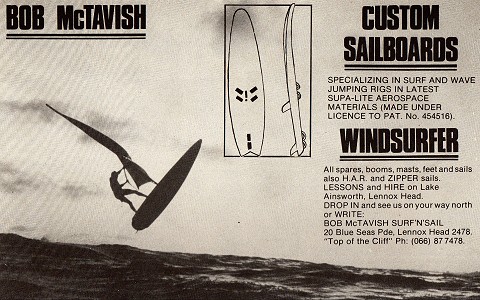 |
| The next swell is
clearly defined, approaching cleanly. My brain is organized. When I feel the swell get under me I'll throw the mast forward to pull the nose around toward the beach and pick up the swell. I think that's the process. Making nice speed, the board lifts as the swell gets under it. I rock the mast forward, the nose immediately swings around like in a cutback, then the surge again as a new force comes into it. Suddenly the sail goes light and the Board is doing the driving, racing off down the face, as all boards do. It feels comforting to know I've been here before. Feet and legs act instinctively to help the nose keep clear, just a simple glide ... But what's this? Five feet of wall is standing. . . looming. .. what comes next? What do I do? Out of nowhere, right on cue, the sail fills just a little and there's sufficient power to simply keep her running just in front of the tumbling soup. II feels GOOD! Easy, controlled ... for the moment. Next minute I'm driving along the bottom |
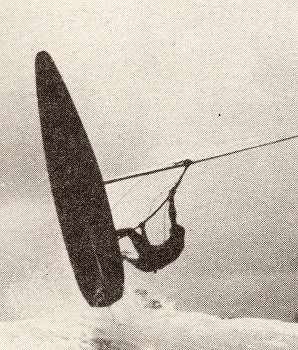 Photograph
by Peter Crawford.
|
We drift off the bank into the hole giving me time to re-rig and give 'er another go. That's the basic run-down on getting into the waves on a Windsurfer sailboard. I mean basic. You've all seen the photos of guys 10 feet in the air, totally flying. If they were to describe the rush of confronting a ten footer at 25 knots it would totally overshadow my comparatively feeble experience. And yet, that's the biggest buzz I've had in the ocean since that perfect swell nearly two years ago, when only half a dozen guys shared a perfect day of 10 foot walls at The Point. Yes, sail boarding is a rush. |
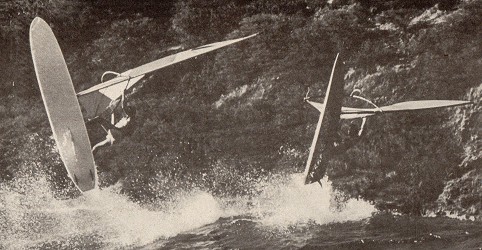 Photograph
by Jeff Devine.
|
| Page 35 It's a piece of cake if a good instructor teaches you the basic starting procedure on the beach first. And if the wind is really light. Don't get fooled by this macho stuff, "Oh I'll need a stiff breeze to give me some stability". Not first time. You've got too much to think of at first to want a wildly flapping sail and tons of force you don't know what to do with. Be humble, you can't fail. Then, when you've got the feel, go find some wind. The surfing side of things is where it's really at. Once you can handle a bit of speed and can do a pretty good speed start, you can think about the waves. Once again, a modest start is best. |
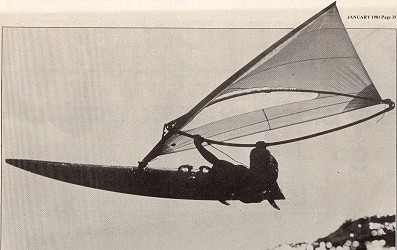 Photograph by
Jeff Devine.
|
| Page 30 |  |
|
Tracks Number 124 January 1981. Understanding the New Materials. By Bob MacTavish Windsurfing - Are you ready for it? By Bob MacTavish Why Gays Don't Surf- or do they? By R.C. Pennie Simon Anderson's Thruster By Nick Carroll |
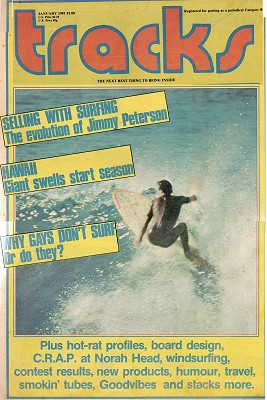
|
|
|
|
|
|
|